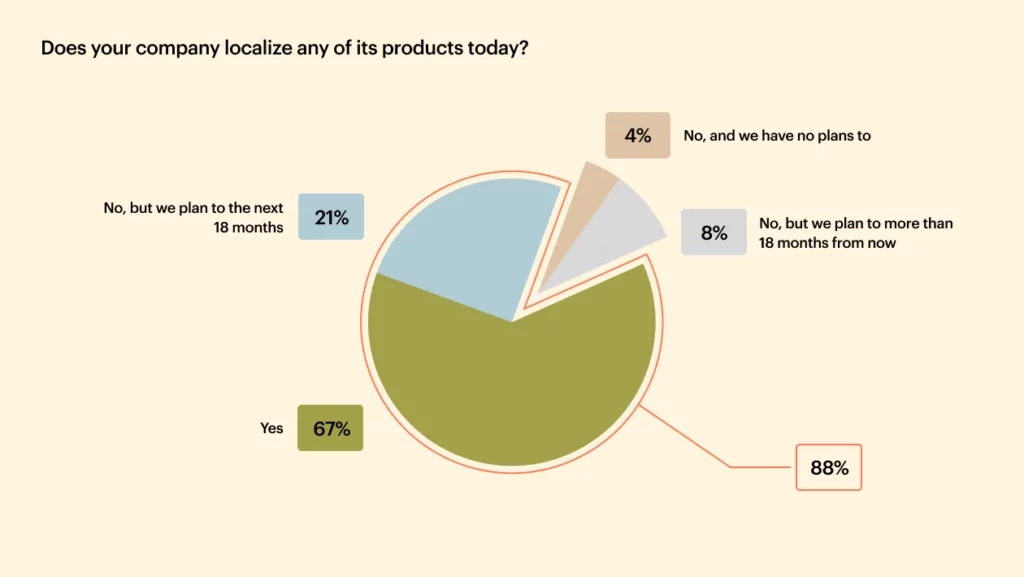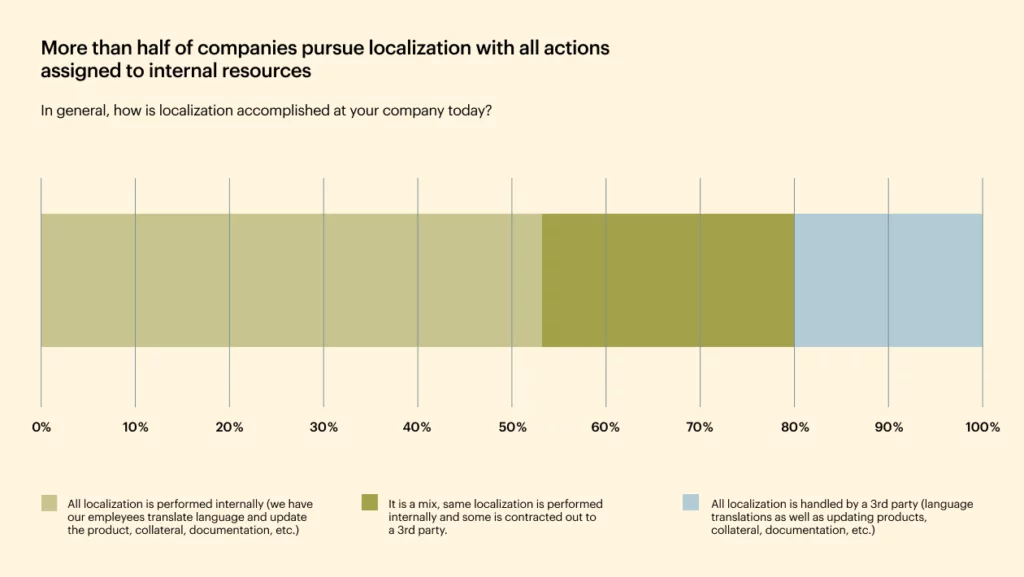Amidst the current economic climate, companies are facing some unprecedented challenges. While the last two years have seen digital transformation supercharged for many organizations, this has taken place against the backdrop of globalization and significant disruption to global supply chains, workforces, and financial markets.
In the face of these challenges, many organizations are looking for new ways to cooperate, communicate, and trade across borders to achieve sustainable growth (I discussed this at length with Reid Christian from CRV recently).
Gladly, localization sits at the core of these efforts. Last year, 78% of scaleups said new market access was ‘critical’ for their growth, and so tailoring products, services, and communications to fresh regions and audiences is playing an increasingly pivotal role for growth.
The adoption of effective localization strategies can significantly enhance a company’s ability to connect with diverse customer bases.
Earlier this year, we commissioned Dimensional Research to investigate just how important localization actually is to the growth plans of companies. They surveyed over 500 executives and business professionals from companies around the globe to try and discover:
- The extent to which companies are engaged in localization in 2022
- The key motivators driving their localization plans
- The major challenges and bumps in the road they anticipate on their journey.
The original intention was to provide us with some internal guidance as we planned for the year ahead and use these insights to shore up our own localization offerings.
However, the results were interesting enough for us to share with the public. Why? Because, quite frankly, we were surprised and think you will be too.
Report: How localization enables growth strategies
What percentage of companies are already localizing? How important is it to their growth plans? What challenges do they face on their road to localization? We asked Dimensional Research to find answers.
DownloadThe how and how many of localization in 2022
One of the most surprising findings our research unearthed is the sheer scale of localization that is already underway. We found that 88% of respondents come from companies which either already localize their products or are planning to do so over the next 18 months.

“Wow, what a great opportunity for a company like Lokalise,” you’re probably thinking. And yes, I’m enthused but it’s made me wonder: how are all of these companies localizing?
88% of companies may be localizing but they are not all using a continuous localization platform. I could be jumping to conclusions here, but when I read that 54% of companies do all localization internally, I sense the presence of spreadsheets, lots of them.
Many companies new to localization rely on spreadsheets to coordinate their processes. As you probably already know, these enormous files are often made up of countless rows and columns that require constant checking and refreshing by a team of translators, developers, and UX designers, who are all forced to collaborate within a program that was never intended for localization projects.
Localization process owners frequently underestimate the complexity and costs required of a project, or otherwise face internal resistance to investing in new tools or changing work methods. This is a topic we’ve discussed at great length before but the prospect of so many companies still relying on spreadsheets is both worrying from an efficiency perspective, and encouraging as it implies there are still a lot of organizations to be convinced about the benefits of a continuous localization platform.
Localization hangovers
I can relate to the negative experiences that respondents have had with localization in the past. Almost all (97%) of companies we surveyed reported having previously experienced localization challenges, of these the most significant were:
- The current process is more costly than expected
- There are more resources than expected
- There are delays to product releases

What is clear is that many current efforts have ‘significant’ resource and time implications for these organizations. These are the very reasons we started Lokalise in the first place, so I certainly empathize with their plight.
Initially, we were just a handful of coders building a product to solve pain that we ourselves were experiencing with our previous company’s Roamer app. We couldn’t find a platform to cater to our needs, with those we tried being clunky, difficult to use, and expensive. So, we built our own.
I’m not suggesting that everyone should go out and build their own localization platform, we’ve done the hard work on that already, but it’s definitely time to explore a new approach.
What’s more, 78% of those surveyed said that a dedicated, integrated, and automated localization solution would be “extremely valuable”.
This suggests that some enterprises are getting fed-up with their current processes and looking to move on from spreadsheets, scripts, and older translation systems towards something simpler and more user-friendly.
The in-house versus outsourced debate
As with most business functions, the debate around whether to outsource or keep things in-house rumbles on. We’ve previously touched upon the fact that 54% of companies perform all of their localization internally, but the question of why sits at the heart of their localization strategies, so it’s worth exploring what this means in action.

First off, “in-house” and “outsourced” localization are not mutually exclusive, and overlap more than you’d think. Any solution is going to require both internal and external collaboration and involvement from stakeholders within an organization.
What matters for this discussion is not the scale of outsourcing necessarily, but the business-critical functions that a localization process should serve.
These include:
- Quality of localized content: the type of expertise needed to achieve the best quality, output control, quality assurance standards, and more
- Agility and speed: time to market and translation turnaround are really key to delivering powerful results through localization
- Financial analysis: the competing opportunity and incremental costs, as well as the resource demands placed on the workforce
- Tech stack: the efficacy of integration between localization features and existing development processes
Any localization solution needs to fulfill some of these critical functions in an effective way to ensure the best results for both the company and the product.
There is more than one way of introducing third-party localization into your business, whether this is through freelancers, consultants, single language vendors (SLVs), language service providers (LSPs), and managed service providers (MSPs, who typically cover everything from localization to information security, project management, staffing and more.) What this ultimately means is that organizations are often adopting a hybrid approach and, based on the survey results, I expect this to remain the status quo.
Tim Durgin, Localization Program Manager at Amazon, previously told us: “From my experience, translation, LQA (linguistic quality assurance), and review are being outsourced but other components of l10n, especially project management and localization engineering, remain in-house.”
Opportunity for sustainable growth
The data shows that localization is a safe and sustaining growth strategy because it enables companies to expand their customer base in a scalable way by serving more people around the world. The big-picture insight from our research is that 84% of the companies surveyed are planning to increase their global footprint through market expansion this year.
We’ve always felt that localization is an obvious growth strategy and the easiest way to dip your toes in the waters of a new market. It offers a cost-effective, sustainable way to diversify investment in another market without having to drive a huge amount of personnel, resources, and funding elsewhere. In the broader context of globalization vs localization, this approach highlights the value of adapting to local needs while still thinking globally. Increasing efficiency also becomes a priority when other growth opportunities disappear during an economic downturn. Localization comes out as a safe bet in addressing both sustaining growth and increasing efficiency.
Businesses of all sizes are already benefiting from localization in this way.
Edward Cooper, Head of Crypto at Revolut, said: “It was clear that when some startups and scaleups began localizing their product, they saw a big uplift in business in other markets. But when you are a very small startup, you have to choose your battles.”
Meanwhile, Elie Mélois, co-founder and CTO at LumApps added: “Localization is key to entering new markets. Lokalise has helped us to streamline the process of translating our product into 18 languages.”
From speaking to many of the companies surveyed, it’s clear that this sustainable growth opportunity is only possible with effective executive and C-Suite buy-in. 51% of our respondents told us that their executive teams make the big decisions about how localization is accomplished.
Take a dip into the data for yourself
Our localization survey relied on the participation of hundreds of different companies from almost every industry, ranging from financial services and technology to manufacturing, retail, logistics, government, and much more, each with unique perspectives on localization as a key component of their market entry strategy.
So if you’d like to better understand some of the major roadblocks and opportunities your business might encounter during your localization journey, we encourage you to dip into the data for yourself and read the full survey.
Report: How localization enables growth strategies
What percentage of companies are already localizing? How important is it to their growth plans? What challenges do they face on their road to localization? We asked Dimensional Research to find answers.
Download





